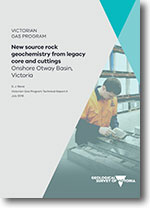VGP Technical Report 4 - New source rock geochemistry from legacy core and cuttings
 |
| |||||
Product description:About the Victorian Gas Program: The Victorian Gas Program (VGP) is a comprehensive science-led program, incorporating geoscientific and environmental research to assess the risks, benefits and impacts of potential onshore conventional gas exploration and production. The program is also investigating the potential for further discoveries of onshore conventional and offshore gas in the Otway and Gippsland geological basins and assessing the feasibility of additional onshore underground gas storage in depleted reservoirs around the Port Campbell area. The VGP includes an extensive, proactive and phased community and stakeholder engagement program, through which the results of the scientific studies are being communicated. Executive summary: New organic geochemistry analyses have been undertaken as part of the Victorian Gas Program (VGP) from selected legacy core and cuttings samples taken from carbonaceous and coal-bearing geological units from Victoria’s onshore Otway Basin. These new analyses complement the existing Geological Survey of Victoria (GSV) data set. As part of the VGP geoscience program, GSV is studying petroleum systems components (reservoir, seal and source), to assess the petroleum prospectivity of the Victorian Otway Basin and estimate the potential for further conventional gas discoveries, onshore and offshore within Victoria’s jurisdiction. Source rocks are an essential component of a working petroleum system. Without source rocks there is no petroleum generation. For petroleum to be generated, a source rock must contain organic matter and it must be of sufficient quality and quantity. The standard techniques for evaluating source rock geochemistry are Total Organic Carbon analysis and Rock-Eval pyrolysis. Hydrocarbons are mostly carbon (by molecular weight) and so the amount of carbon in a rock, to some extent, determines the ability of the rock to generate hydrocarbons. A measure of the organic richness of a rock is known as Total Organic Carbon (TOC). The type of organic matter (kerogen) in the source rock is also important. The type of hydrocarbons that are generated (i.e. gas or oil or both or none) are dependent on the kerogen type. Pyrolysis is a type of analysis where a rock sample is heated to assess source rock quality and the quality of the hydrocarbons it might generate. Together, the TOC content and Rock-Eval pyrolysis data can be used to evaluate source rock richness and quality, kerogen type and thermal maturity. Intertek Pty Ltd (Intertek) in Perth was commissioned to measure TOC content and perform Rock-Eval pyrolysis on 787 samples taken from 54 wells and boreholes provided by GSV. The cores and cuttings were selected from GSV’s Drill Core Library in Werribee and included fine-grained carbonaceous and coal-bearing units and formations containing organic matter, mainly from the Otway and Sherbrook groups with a small number of samples from the Wangerrip Group. Quantitative TOC analysis was performed on prepared samples of dried and pulverised core and cuttings using a Leco® analyser. Samples that returned ≥0.4 wt% TOC are considered potentially viable for generating hydrocarbons and underwent qualitative analysis using Rock-Eval pyrolysis. Pyrolysis of the samples yielded data for in-situ hydrocarbon content, generative potential and thermal maturity properties of the samples. Preliminary analysis of the data indicates that the new dataset broadly agrees with legacy measurements. Samples from the Eumeralla Formation, Killara Coal Measures and the Casterton Formation had a greater range and higher TOC values than other formations included in the study. All results from the pyrolysis indicate that the source rocks from the onshore Otway Basin contain Type II/III kerogens and are gas prone. A range in generative potential was recorded over all formations with the Eumeralla Formation having the highest organic matter quantity at 60.99 wt% TOC and the most consistent high ranging generative potential at an average of 6.95 mg HC/g rock (with a range of 0.11-179.03 mg HC/g rock). Organic geochemistry data from the Casterton Formation is likely to underestimate the generative potential in Victoria, as rock samples have not yet been intersected by drilling deep enough in depocentres such as the Penola Trough. The laboratory measurements presented in this report are being used to complete comprehensive source rock studies to assess the gas prospectivity of the Otway Basin by mapping the distribution, thickness and quality of the source rock units. The data will be incorporated into petroleum systems modelling to assess the petroleum prospectivity of the Otway Basin and estimate gas resource potential. Bibliographic reference: Revie, D.J., 2019. New source rock geochemistry from legacy core and cuttings, Onshore Otway Basin, Victoria. Victorian Gas Program Technical Report 4. Department of Jobs, Precincts and Regions. Download: The downloadable version of this report is supplied in PDF format (7.0 MB), Attachment A1 (zip 2.9MB), Attachment A2 (PDF 13.0MB) & Word accessible version (DOCX 4.2MB). | ||||||

